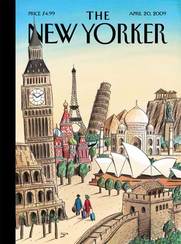Emdashes—Modern Times Between the Lines
The Basics:
About Emdashes | Email us
Ask the Librarians
Best of Emdashes: Hit Parade
A Web Comic: The Wavy Rule
Features & Columns:
Headline Shooter
On the Spot
Looked Into
Sempé Fi: Cover Art
Sempé Fi (On Covers): Journey's End
Filed under: Sempé Fi Tagged: art, covers, Frank Gehry, Jacques de Loustal, Pollux, Renzo Piano, Richard Meier, Silvio Berlusconi

Pollux writes:
A collection of world monuments grace the cover of the April 20, 2009, issue of The New Yorker. These are the landmarks you have to see before you die—or at least, that's what people say. It may be that one becomes reincarnated as a docent at the Taj Mahal or a Qualified, Talented, Experienced, Enthusiastic, Friendly employee of Walking Tours of Pisa, thus making your travels in this lifetime pointless.
Despite the world's construction efforts and fervid competition between nations, the list of famous world landmarks has remained fairly standard over the past half-century or so. New buildings and structures have not supplanted Big Ben, the Eiffel Tower, and the Statue of Liberty. The London Eye has not become the landmark most associated with London.
In Italy, efforts to recreate the "Bilbao Effect," the economic boom that occurred after the building of Frank Gehry's Guggenheim Museum in that Basque city, have produced exciting, interesting buildings (Renzo Piano's Parco della Musica; Richard Meier's Jubilee Church; Meier's Ara Pacis Museum), none of which are instantly recognizable landmarks, although we can judge Berlusconi's Ego to be a recognizable Italian landmark.
China, despite gargantuan Olympic efforts, still relies on that ancient but great Wall to the north, as ineffective against marauding Mongolians in centuries past as it is effective at pulling in tourists.
Jacques de Loustal, who is, according to his website, a fan of the Fauvists, here holds back from the vivid coloring that characterizes his work and that of the Fauvist movement. His New Yorker cover is almost lugubrious, as if he were expressing the fact that all of the challenges and adventures associated with traveling are gone. Gone are the strong reds and bright blues that usually characterize his work.
His cover, entitled "Ultimate Destination," is ultimately an exercise in sobriety, displaying little of the playfulness seen in his other travel-themed cover for The New Yorker, for example, which depicted two travelers dressed for a hard winter strolling across an exotic, subtropical beach.
"How do you see these trees? They are yellow," Gauguin once advised. "So, put in yellow; this shadow, rather blue, paint it with pure ultramarine; these red leaves? Put in vermilion." De Loustal puts in none of these. Perhaps it is intentional. All travel requires these days is a stroll in a graveyard of monuments, where we're immunized from "real life" in Russia, China, or Australia, for example. Perhaps we are all traveling gnomes when we travel, and all we require is to have our picture taken in front of a landmark. And then we move on. We have conquered and landmark-spotted the monuments on our list, and now we can ignore the country and the routes that surround them.
The famous monuments have been transplanted for the benefit of two well-dressed travelers, who drag Samsonites down an unmarked and lonely route. The Statue of Liberty shares the same Loustalian waterway with a Venetian gondola, while the Parthenon looks over both. The Leaning Tower of Pisa tilts perilously close to the Pyramids while the Eiffel Tower remains as ramrod straight as a 1,000-foot baguette.
The world is flatter and the world is smaller. In this shrunken world of ours, it is possible to get a picture taken in front of St. Basil's Cathedral and the next day find oneself at the Sydney Opera House's gift shop, located in the lower concourse of that New South Wales landmark. You'll be exhausted, of course, which will explain your purchase of a box of authentic tile fragments collected during the building's original construction and sold for 135 Australian dollars.
As the Spanish say, "el mundo es un pañuelo"—"the world is a handkerchief," and the world has become more a single ultimate destination devoid of context than a series of diverse, disparate locations.





Comments
Why did Jacques de Loustal draw Big Ben with the time set at 10:10?
Not sure, Paul, but it may have been simply an aesthetic decision. Check out: http://www.snopes.com/business/market/clockhands.asp
What is the building in the lower left corner of this cover??? A bullfight arena in Spain or The Coliseum in Rome? You already have the Leaning Tower for Italy and no other country is represented by two monuments. This is driving me crazy!
Virginia, it’s the Coliseum that he’s depicting specifically the partially intact outer wall, which is cut at that angle (a photo can be seen here: http://en.wikipedia.org/wiki/File:Colosseum_in_Rome,_Italy__April_2007.jpg)
As it happens, Italy gets two monuments, while Spain gets none. Barcelona’s Sagrada FamÃlia would have been a good choice (or the Escorial), but Loustal seems to be going for what most people think of when one talks about “world landmarks.”